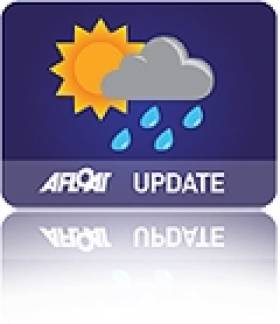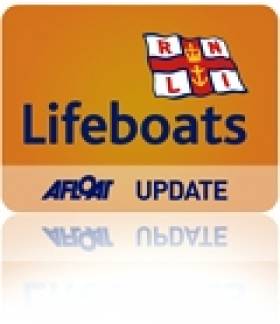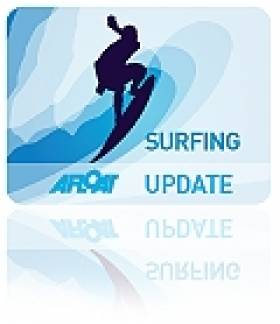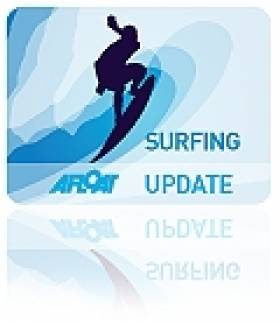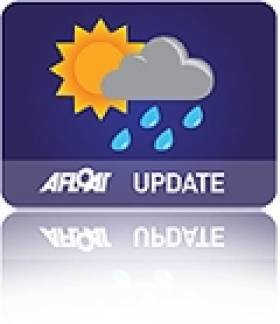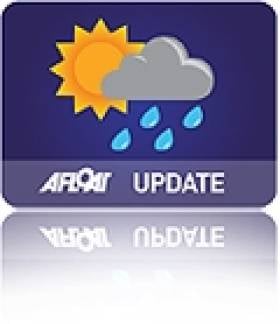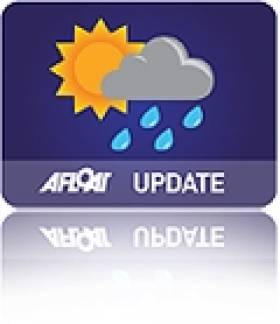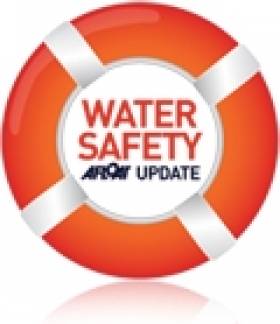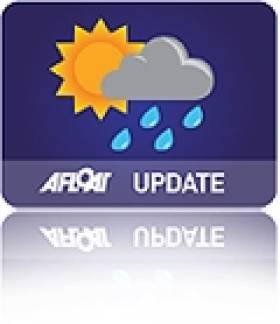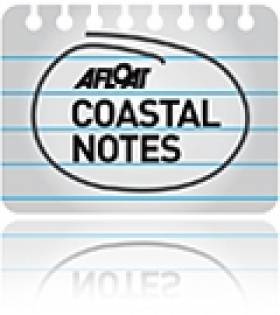Displaying items by tag: Weather
Met Éireann Issues 'Yellow' Alert As Strong Gales Sweep Coast
#Weather - Met Éireann has issued a 'yellow' weather alert for coastal areas around Ireland today (4 February) as winds are expected to reach speeds of up to 110km/h.
Westerly winds will continue to reach gale force or strong gale force this evening and tonight on all Irish coastal waters and on the Irish Sea.
Severe gusts of 90 to 110 km/h are predicted for Connacht, Donegal and in coastal areas of Munster. Elsewhere winds will gust between 80 and 90 km/hr.
After dark, showers will become increasingly wintry with the possibility of snow and even blizzard-like conditions, especially in the north and west on high ground.
But meteorologists say that any lying snow will melt during the course of tomorrow morning and afternoon as temperatures rise.
Lifeboat Rescues Windsurfer In Stormy Conditions
#RNLI - Kilkeel RNLI rescued a windsurfer who got into difficulty in Carlingford, Co Louth yesterday (Tuesday 29 January).
The charity’s volunteer lifeboat crew was requested to launch by the Irish Coast Guard shortly after 2pm following a report that a windsurfer had got into difficulty in Carlingford Lough.
Launching their inshore lifeboat immediately, the crew encountered very unfavourable weather, with strong westerly winds of between force six and seven.
The lifeboat proceeded up the lough where they found and retrieved the windsurfer who had stayed by his board. The crew then attempted to retrieve the sail and board but couldn’t due to the windy weather conditions. They instead proceeded to tow the board into Greenore where the local coastguard took over.
Despite being in the water for approximately an hour, the casualty was described as being in reasonably good health.
Roy Teggarty, Kilkeel RNLI lifeboat operations manager, paid tribute to the lifeboat crew for their efforts in what was a challenging rescue:
"This was a day with difficult conditions because of the strong winds," he said. "It was mainly difficult to keep the lifeboat steady when retrieving the casualty so this rescue involved expert boat handling by all involved."
Big Waves Come to Mullaghmore After Long Wait
#Surfing - Some of the world's top big wave surfing talent enjoyed the 'day that almost never was' at Mullaghmore in Sligo on Sunday.
As the video above shows, competitors in the long-delayed Billabong Tow-In Session finally got a chance to prove their mettle after two amber alerts in a week for the international event, pushed back from last year after a calm storm season.
Confidence was high as the storm front that has been battering Ireland for the past two days made its way across the Atlantic, bringing with it the giant swells needed to green-light the action.
Big wave surfers being secretive sorts, due to the dangerous nature of offshore tow-in surfing and their determination to keep their favourite spots 'just for them', we don't yet have results of the action, or even confirmation that the waves were big enough to count!
But what we do know is that the likes of Billabong XXL 2013 Ride of the Year nominee Peter Conroy were present and ready to tackle the colossal walls of water Mother Nature was set to provide.
Meanwhile, Met Eireann warns that gale force winds are expected to continue today (29 January) with southwesterly gusts of up to 110 km/h possible. Those in coastal areas have been warned to exercise caution.
Windsurfers Race to Kerry for Red Bull Storm Chase
#Windsurfing - Due to 2012's calm storm season, organisers of the Red Bull Storm Chase recently extended the competition into this year - and competitors are currently racing to Ireland for the first mission of the contest.
Brandon Bay in Kerry was decided as the spot early this morning, and the competition is scheduled to begin just after sunrise tomorrow (Monday 28 January) when stormy weather conditions are expected to be at their peak.
The Red Bull Storm Chase website has live updates from competitors making their way to Kerry from as far away as the Marshall Islands in the Pacific Ocean.
Ten windsurfers chosen by community vote will take part in the first mission, with the top six going on to the second mission some time before 22 March at any one of seven possible destinations around the world, most of which have not before taken centre stage on the windsurfing scene.
Sadly no Irish windsurfers will be competing this time round, but names the likes of Timo Mullen and Dan Gardner on the shortlist will surely be keeping an eye on the competition as they get set to chase the ride of their lives.
Public Warned To Avoid Coastal Areas As Storm Force Winds Sweep In
#Weather - The Irish Coast Guard has warned the public to stay away from coastal areas today (Friday 28 December) as high winds are expected to reach speeds of as much as 140km per hour in some exposed areas.
It marks the third weather warning for gale force winds this week, as Met Éireann advises of south to south-west winds developing during the day with gusts of 90-100km per hour.
Exposed parts of Connacht and Donegal are set to face the worst of the storm-force winds, with severe gusts of storm force 10 - 100-140km per hour - expected between 6pm and 9pm on the coast from Slyne Head to Erris Head to Malin Head.
Speaking to The Irish Times, meteorologist John Eagleton suggested the possibility of trees coming down and electrical poles falling as the winds strengthen over the course of the day.
"We will get a blast around the evening time," he said, "and I wouldn't like to be sailing a boat along the west coast during those hours."
Small Craft Warning For St Stephen's Day As High Winds Return
#Weather - After a relative lull for Christmas Day, Met Éireann warns that the high winds that swept across Ireland at the weekend will make their return today (26 December).
A small craft warning has been issued with west to southwest gales expected to reach force 6 or 7 this afternoon on coasts from Carlingford Lough to Wicklow Head to Carnsore Point.
Winds will also occasionally reach strong gale force this afternoon between Loop Head and Erris Head.
The weather service reports that westerly winds will reach up to 60 km per hour this afternoon and early evening with gusts of 70-100 km at their strongest in west Connacht.
Met Éireann Warns Of Storm Force Winds Around Coast
#Weather - Met Éireann has issued a weather warning for tonight (Saturday 22 December) with winds expected to reach up to 110km an hour.
Tonight and tomorrow morning, south-west to west winds are likely to increase in most parts of the country, with mean speeds and gusts that "have the potential to be damaging".
The Irish weather service also reports strong gales on all Irish coastal waters and on the Irish Sea, with winds expected to reach storm force later on coasts from Valentia to Erris Head to Fair Head.
RNLI Seeks Responses in Sea Safety Advice Survey
#SAFETY AT SEA - How do you use weather forecasts to plan your leisure time on the water?
The RNLI asks all water users in the UK and Ireland to take a quick 10-minute survey by the UK's Met Office.
Its results will help meteorologists and rescue teams to better understand sea users in order to give better water safety advice and save more lives through preventative action.
Take the survey HERE by 3 December.
Going out on the water can be a lot of fun, and is a way of life in coastal communities around the UK and Ireland. But the sea can be an unpredictable and dangerous place.
Taking some simple precautions can make your time on the water even more enjoyable, and reduce your chances of getting into trouble.
The RNLI has an interactive publication, Sea Safety: The Complete Guide, which is essential reading for anyone who finds themselves drawn to the water.
Met Éireann Issues Small Craft Warning as Rain and Winds Sweep In
#WEATHER - Met Éireann has issued a weather warning for much of the Irish coast today (Monday 24 September) as heavy rain and strong northwesterly winds sweep in across the country.
Winds are expected to reach gale force tonight on northwestern, northern and eastern coasts from Erris Head in Mayo to Malin in Donegal to Wicklow Head.
As The Irish Times reports, fishermen in small craft are advised to take caution as wind speeds are set to top force six or higher as the day progresses.
Persistent rainfall in most of Leinster and Ulster may also lead to flash flooding in some areas.
Irish Sea Level to Rise Almost 50cm by 2099
#COASTAL NOTES - It's an alarming figure by any means - new research shows that the level of the Irish Sea will rise by almost half a metre by the end of the century, leading to much more severe flooding along the east coast and elsewhere.
The results of research published by the Ryan Institute at NUI Galway, as reported by The Irish Times, show that sea level rises of up to 47cm are not out of the question.
They also indicate that sea surface temperatures will increase by nearly 2 degrees, which would have serious implications for marine wildlife and the fishing industry.
Dr Mike Hartnett of the Tyan Institute said the new research - from 3D model-based projections of the seas around Ireland - is the most comprehensive study of its kind, and confirms previous "tentative" studies in the area.
The news comes after national weather forecaster Met Éireann announced an incredible 0.75 degree rise in average temperature in Ireland - and a 5% increase in rainfall - over the past two decades alone.
And with recent flooding in Cork and Belfast causing millions of euro worth of damage, the real implications of such figures is coming closer to home.
The Irish Times has more on the story HERE.


























